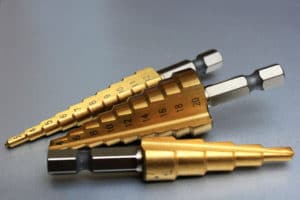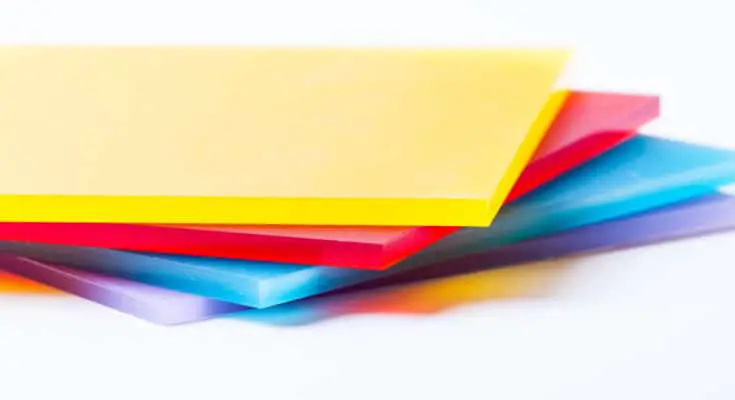Odds are that you have purchased or used plexiglass in your home without even realizing it. Many times, things such as the “glass” in a picture frame or other type of artwork is made of plexiglass.
The great thing about using plexiglass in a project is that it is more durable than glass and it can be modified much easier. In addition, plexiglass is much lighter than regular glass which is great if you need a large piece that will be hanging from a wall or ceiling.
Having an article about plexiglass on a woodworking site may come as a surprise to you, but I found that as my woodworking skills increased, I began to use plexiglass in my shop. Therefore, I wanted to take a moment and write an article that gives you all the info you need to know and how you can incorporate it into some of your woodworking projects.
History
Plexiglass was first developed around 1928 but didn’t come to market until 5 years later in 1933. Oddly enough, there is no single person credited with creating plexiglass. Instead, a handful of people are credited with creating it around the same time in different labs around Europe.
The demand for plexiglass increased significantly in World War II because both sides discovered that combat pilots suffered significantly less serious injury from shattered plexiglass than glass. (Source)
What are its uses?
Plexiglass can be used for a wide variety of products due to it’s clarity, strength and weight. It’s often that you will find plexiglass used for small items around your house like picture frames, display boxes and even the backboard on a basketball goal. Plexiglass is popular in these applications because it’s so much lighter than regular glass.
As we mentioned above, plexiglass was used on the windshield of fighter jets in WWII. The practice of using plexi on vehicle applications has increased since that time. Now it’s common to find motorcycle windshields as well as helmet shields made from the material. It’s also common to find plexiglass used on small airplanes as well.
Many people are starting to use plexiglass in the windows to their homes over the past few decades. Plexiglass is much more energy efficient that glass and weighs about half that of glass. The fact that plexiglass is shatter resistant also makes it a popular choice for this application. The only negative to using plexi in a window on your home is that it is a bit costlier up front, however the energy efficiency gain will make up for it in time.
What are the differences between plexiglass and polycarbonate?
Trying to understand the differences between plexiglass and polycarbonate is no simple tasks. The difficulty is due to the terms being used interchangeably throughout the plastics industry. I’ll explain the differences between each below. As you’ll see, they are all very similar, but each have their own unique characteristics that make them stand apart from the others.
Before we start, it’s important to understand that acrylic sheets can be produced using one of two methods. These methods are referred to as “extruded” or “cell casted.”
Plexiglass – The first thing to understand when it comes to plexiglass, is that it is often spelt two different ways. The variances in spelling certainly contribute to some of the confusion in each of the different types of plastic sheeting. For plexi, it’s common to see it spelt “plexiglass” and also “Plexiglas.”
When you see it spelt with one “s”, it is referring to the brand name of plexiglass. When you see it spelt with two s’s is simply the generic term for the material.
 As I mentioned earlier, one of the qualities that makes plexiglass so popular is its clarity and resistance to shattering. It’s also very easy to buffer out scratches (See “Common Related Questions” below for information on how to remove cloudiness and scratches).
As I mentioned earlier, one of the qualities that makes plexiglass so popular is its clarity and resistance to shattering. It’s also very easy to buffer out scratches (See “Common Related Questions” below for information on how to remove cloudiness and scratches).
The one thing that sets plexiglass apart from the other types of acrylic sheeting is the process in which it is made. Plexiglass is only made using the cell casted method. This method is more expensive than the extruded alternative but produces a sturdier product.
Polycarbonate is sometimes referred to as Lexan which is just the brand name. Polycarbonate is a much stronger form of acrylic. Polycarbonate is often used in the “glass” around hockey rinks and can even be made to be bulletproof.
Polycarbonate is less likely to be found in your local big box store. Often, you’ll need to special order it online.
Is Plexiglass as clear as glass?
Plexiglass allows anywhere between 90% – 92% of light that hits it to pass through it. Glass on the other hand, only allows about 80% of light to pass through it.
In addition, plexiglass does not distort the color of light when passes through it which makes it a great choice to using when creating signs. As the thickness of glass increases, so does the amount of color distortion. Plexiglass does not impact color at all.
How To Cut Plexiglass
Fortunately, there are several ways to go about cutting plexiglass. Some are quicker and easier than others, however, the cost of blades vary depending on the method you choose. Below we will cover each of the options available.
By Hand
If price is the primary concern for you, then the best option for cutting your sheet of plexiglass will likely be to do it by hand. The process of doing it by hand is known as “scoring.” This is also a very common practice when cutting glass.
This method works by the user scoring the plexiglass by using a small tool that has a sharp edge. You’ll slide the scoring edge of the tool over the plexiglass several times to create a weak point in the glass. After several passes, the plexiglass will develop a visible line. At this point, you’ll gently line the weak point up to the side of a table and press down. If you scored the plexiglass correctly, it will snap along the line that you scored.
The great thing about this method is the small number of tools required. You can pick up a scoring tool for under $15. The drawback to this method is that the break doesn’t always go according to plan.
If you don’t score the piece evenly, it is possible that it will snap somewhere other than the line you scored. If this happens, you are left with figure out a way to salvage your piece and hope you can clean up the uneven edge. Worst case scenario is that you have to trash the piece altogether and start over.
If you choose to use this method, make sure you use a straight edge to line your scoring tool up against. Clamping a straight piece of wood or metal along your piece so that you cut in the same straight line with each passing score is extremely important.
As I said above, scoring tools are very inexpensive. This particular tool has very positive reviews on Amazon.
Using a Table Saw
It is possible to cut plexiglass with a table saw. This method is probably the quickest method to get the job done and it gets great results.
However, to get great results, it’s very important that the blade you are using is made for cutting plexiglass. A regular woodworking blade will not produce good results. Using the wrong blade will likely result in the plexi chipping along the edge that was cut.
Here’s a couple times tips to help ensure you get the perfect cut
- If the plexiglass you are cutting still has the protective film on it, you should leave it on while making the cuts. This will help ensure your plexiglass doesn’t get scratched up during the cutting process. If the film has already been removed, just be sure to vacuum the top of your table saw to ensure there’s not debris on top that can cause scratches as you cut.
- If possible, use a table saw sled if you have one. This will help to ensure your cut is clean and it gives you more control during the cut.
- Pay attention to how well your blade is cutting. If you have a new blade, it should be able to cut thru the plexiglass with no issues. If you are using an older blade, you may have to push the plexi through the blade slower to ensure it doesn’t chip or crack.
Though cutting with a table saw is probably the quickest option, the blade is more expensive than some of the other options that we will cover. This may not be the best option due to cost if you are only looking to make a few small cuts.
The best blade for cutting plexiglass on a table saw is made by Diablo. It creates a very smooth edge and has no trouble handling the plexiglass. You can pick this blade up on Amazon, by clicking here.
Here’s a video that shows someone using the Diablo while cutting a piece of plexiglass. You’ll see he is able to get sharp, clean edges with the blade.
Using a Jig Saw
If you don’t have a table saw or aren’t interested in a purchasing a special blade for your table saw to cut your piece of plexiglass, the jigsaw method will probably be your best option. This method is problem the best even if you don’t have a jig saw. You can pick up a budget jigsaw and the blades needed to cut the plexiglass for under $50. A jigsaw is a great tool to have around the house as it can make tough cuts that others saws aren’t able to.
The best jigsaw blades that I have found to cut Plexiglass are made Bosch. You can pick them up on Amazon , by clicking here.
If you are in need of a jigsaw, this particular model by WEN is a nice entry level option. Obviously, more expensive options are available, but this is a great little entry level saw.
Here’s a great video shows how well the Bosch blades work as well as how to cut your plexiglass using a jig saw.
How to drill plexiglass
Drilling a hole into plexiglass is not difficult as long as you plan out your cut and don’t get into a hurry. Just like with saw blades, you’ll want to make sure that the drill bit you are using for your cut is made for drilling plastics. Using a bit build for drilling into metal or wood may not provide good results.
When purchasing a bit, you have a couple different options available to you. You can pick up a variety pack, like this one on Amazon that comes with a few different sizes.
Another option, and one that I prefer, is that you can pick up a set of step down drill bits. This specific set on Amazon, is excellent. I have a couple sets and love how they perform. These bits work, by starting off with a making a small hole in your material and slowly increases to your desired size.
 No matter which type of drill bit you decide to use, you’ll want to take a couple steps to ensure your plexiglass doesn’t crack during the drilling process.
No matter which type of drill bit you decide to use, you’ll want to take a couple steps to ensure your plexiglass doesn’t crack during the drilling process.
The first think you’ll want to do is to set the piece of plexiglass you are cutting on top of a scrap piece of wood to help provide it with a firm foundation. Make sure it’s a scrap piece of wood, because you will drill into the wood during the process.
The second thing you’ll need to do is to ensure that you don’t drill too quickly. Take your time and slowly lower the bit into the plexiglass to prevent it from chipping or cracking during the process.
Lastly, it’s also wise to clamp down the piece of plexiglass that you are cutting to ensure that it remains in place and doesn’t move while drilling.
Common Related Questions
Is Plexiglass Bulletproof?
An interesting question I’ve heard is if plexiglass can stop a bullet. Technically speaking, the answer is no. Plexiglass is not bullet proof. What is bulletproof is Polycarbonate which is like plexiglass but more expensive.
To get bulletproof polycarbonate, you have to ensure that it is rated as bulletproof. In order for a piece of it to be considered bulletproof, it must be rated using the Underwriter Laboratory (UL) standards.
Even after it has this rating, there are categories that determine what size bullet the polycarbonate can stop. A level 1 piece can stop up to three 9mm bullets. While a level 10 can stop a single 50 BMG bullet.
Can You Paint Plexiglass?
Yes, you can paint plexiglass. However, you must ensure the paint you are using works well with acrylic, otherwise it won’t stick properly. The two best types of paint to use are general acrylic paints that you can find at your local craft shop or any spray paint that states it will stick to plastics. Here’s some of the examples of spray paints that will stick to Plexiglass.
Can Plexiglass melt?
Yes, Plexiglass can melt, however, only at very high temperatures. Plexiglass will not melt until it has a reached 320 (F) degrees. Therefore, it should be fine to use in almost all household applications unless it’s around a stove, furnace or wood burning stove.
Why Does Plexiglass Get Cloudy?
Over time, plexiglass can develop a cloudiness that may prevent you from being able to see through it. This can happen for several reasons.
One possibility is that your plexiglass has become scratched over time. These cracks can be very small, but over time it will cause the plexi to appear cloudy. If you do have cracks or scratches in your plexiglass, it is important that you don’t apply heat. Heat will cause the scratches and cracks to expand rapidly and could cause the plexiglass to break altogether.
Another reason that it could get cloudy is if you have used improper cleaning products on it. You should never use Windex on a piece of plexiglass. The chemicals in it will away at particles in the plexiglass which will also cause it to become cloudy and lose its clarity.
The easiest way that I have found to get rid of the cloudiness that appears in plexiglass is using a product called Novus. It works by cleaning and filling in scratches to restore the original clarity. Novus comes in three different levels depending on how bad your piece is scratched. Level 1 is for polishing and cleaning. Level 2 is for light scratches and Level 3 is for heavily scratched pieces. I’ve always had the best success with level 1. You can get the Level 1 bottle on Amazon here. If you’d prefer a sample pack of all three levels, you can get that here.
Does Home Depot or Lowes Sell Plexiglass?
Yes, both Home Depot and Lowe’s sell plexiglass in their stores. You should be able to find in stock sizes ranging from an 8×10” on up to 3×4 feet. A sheet of 8×10 plexiglass will cost around $4 depending on where you are located.
Hobby Lobby is another great source for plexiglass if you are looking for a wider range of options for smaller pieces.
Does Home Depot or Lowes cut plexiglass?
This answer will vary depending on where you live. Most Home Depot or Lowes locations will not custom cut a piece of plexiglass. However, I have spoken to people in various parts of the country that have told them their local store will do custom cuts.




